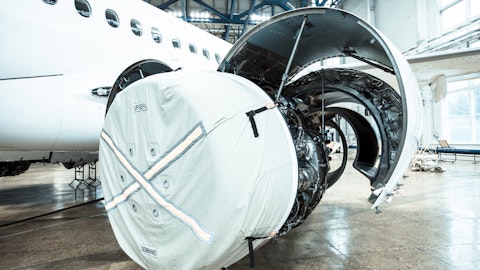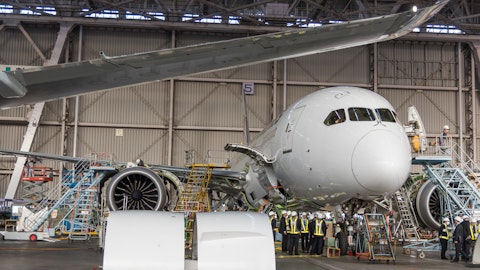Mark Hartman: Okay. I understand where you’re going from that question, Chris. Thanks for that. What we see right now, like you said, is we’re taking very specific actions going after the problems that we see. And we’ve been able to show some progress in certain areas, whereas we’re reducing the number of suppliers that are having problems and behind on their deliveries to our input, and we’re reducing the number of parts that we’re chasing. But we continue to be surprised by other suppliers that fall down in the process. And so we’re we don’t feel strong enough and incredible enough that we can claim a sustained ability to support the customer demand just yet. We would like to bring more parts inside. We’d like to have our machinists come up the learning curve a little bit more and have it demonstrated sustainability to see that increased output before we would start to claim any victories on that front.
We are taking the actions we think that are necessary and prudent and we’re even redeploying resources that would, on normal days, look like excessive to go after supplier improvements and internal factory optimization. But we believe that sort of resource over deployment is what’s required right now.
Chris Glynn: Great. And then on the industrial margin profile, I understand a lot of what we just talked about is germane to both segments. I am curious, one thing you didn’t I haven’t heard you talk about. Is there any issue with SKU complexity and breadth or excess customization? Maybe what the front end is feeding into the factories could be optimized a little more. I’m just curious, brainstorming if that is an article of discussion in your offices?
Mark Hartman: Yes. Your curiosity is justified, Chris. Me being in the role now a number of months, not still learning and coming up the learning curve, but that is one observation that I make is that we have a lot of complexity. We have some a lot of aged components and systems that don’t get a very steady stream of orders and our ability to look across the product line portfolios and potentially optimize that going forward. Simplification can drive velocity and focus, and that’s one of the things that we’ll be taking a look at in 2023.
Chris Glynn: Thank you.
Operator: The next question is from Pete Skibitski with Alembic Global. Your line is open.
Pete Skibitski: Hey, good afternoon, guys.
Chip Blankenship: Hey, Pete.
Pete Skibitski: Hey, guys. If I heard you right in terms of the COVID disruption, the way you quantified it for the fourth quarter, I think you said $40 million for Aerospace. I think that was $55 million in the third quarter. So are things at least trending somewhat in the right direction in Aerospace, but you’re kind of in the same ballpark of $45 million in arrears and industrial. Is that right?
Mark Hartman: That’s correct. We have seen some improvement. But as far as how sustainable that is and if that’s a trend, we can keep connecting the dots on. We haven’t demonstrated that in a way that I could say with confidence that our first quarter is going to be better than the fourth quarter of last year. We certainly have the momentum of resources in place but being able to realize that and say we’re going to continue to march that down right away here would be probably too optimistic saying that we’re going to make progress throughout the entire fiscal year, we are making that commitment.
Pete Skibitski: Okay. And then just what are you guys assuming for FX headwind in fiscal 2023? Because it seems like you’re talking about a pretty good demand environment for industrial. But obviously, kind of a low single-digit type of average guidance there for industrial. So I’m just trying to figure out if it’s more so supply chain or more so FX? Or I don’t know if you can bifurcate a little bit for us.





